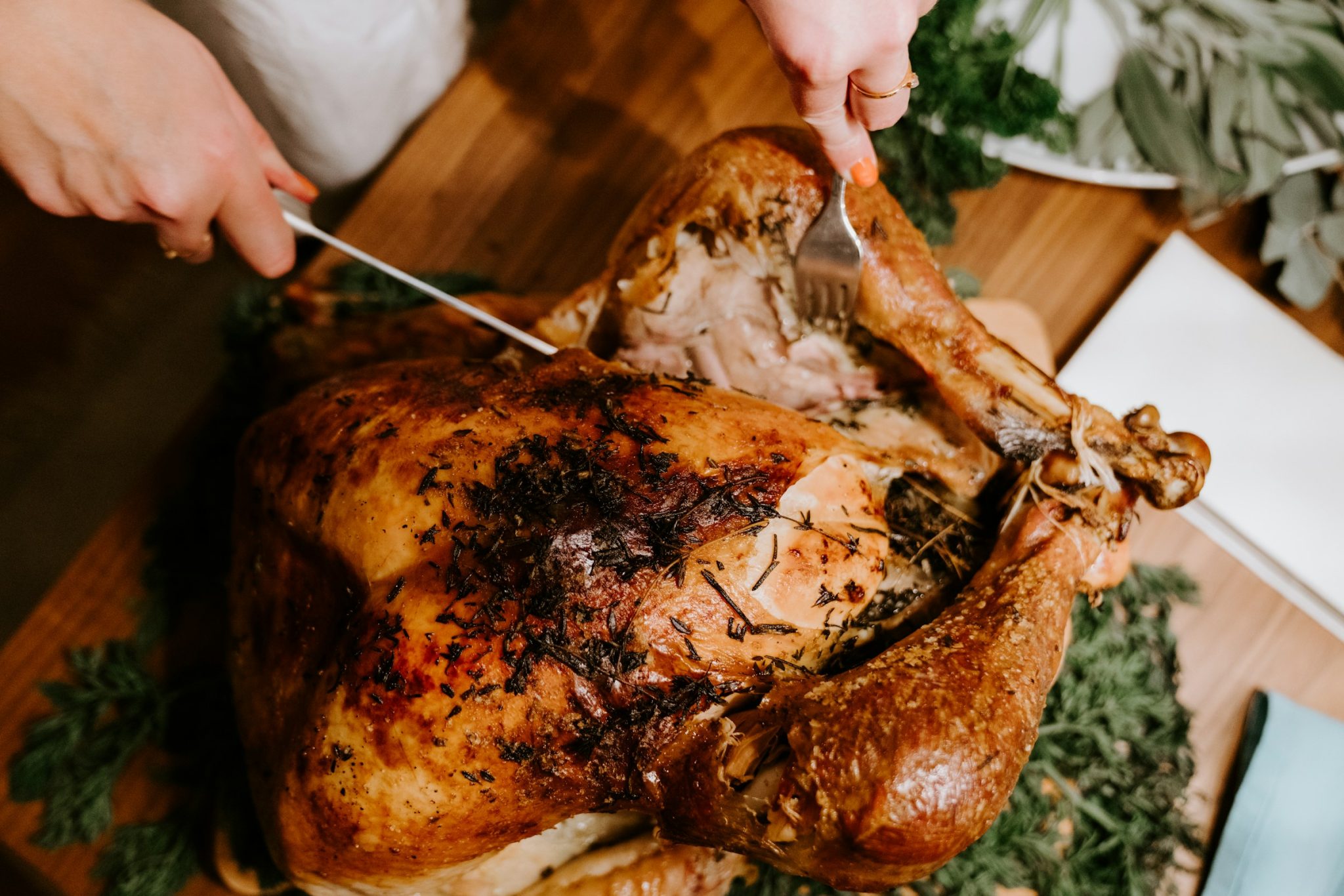Our Guide to Terrific Turkey This Christmas

Introduction: Why Turkey is a Christmas Tradition
Christmas dinner has seen many forms over the centuries, from extravagant feasts of peacock adorned with feathers to swan and goose gracing the tables of festive revelers. Yet for the past century, turkey has become the quintessential centerpiece, symbolizing the holiday meal in the UK. Once a luxury for the wealthy, turkey became more accessible in the mid-19th century, gradually overtaking goose as the nation’s festive favourite.
Despite its iconic status, turkey isn’t universally adored. Some find it dry or lacking the depth of richer meats like goose or beef. However, with the right preparation, a well-cooked turkey can be tender, flavourful, and truly deserving of its place at the heart of your Christmas table.
In this guide, we’ll take you through every step to achieve turkey perfection, from selecting the right bird to mastering roasting techniques. Whether you’re a first-time cook or a seasoned chef, you’ll learn how to create a show-stopping turkey that will have everyone asking for seconds.
Section 1: Choosing the Right Turkey
The journey to a perfect Christmas turkey starts with selecting the right bird. Your choice can make all the difference between a show-stopping centerpiece and a meal that falls flat. Here’s what you need to know.
Types of Turkey: What’s the Difference?
- Free-range: Raised with room to roam, these turkeys develop more flavourful meat. A great choice for those prioritizing taste and welfare.
- Organic: Free of synthetic pesticides and antibiotics, organic turkeys offer a richer, more natural flavour.
- Frozen vs. Fresh: Fresh turkeys skip the thawing process, while frozen options are more affordable. If choosing frozen, plan ample thawing time.
Understanding Turkey Breeds
- Bronze Turkey: Known for its gamey, flavourful meat, often found on free-range farms—a traditional choice.
- White Turkey: The supermarket standard, offering mild flavour and lean meat. Reliable for crowd-pleasing.
- Heritage Breeds: Breeds like Norfolk Black or KellyBronze provide a richer, gamey taste for those seeking something special.
Size Matters
- Portion Guide: Aim for 500g per person to include bones and leftovers.
- Smaller Options: For intimate gatherings, turkey crowns or rolled joints are easier to prepare and carve.
Where to Buy
For superior flavour and quality, source your turkey from local butchers, farm shops, or reputable online retailers. Free-range and organic options support sustainable farming and deliver better taste. Be sure to order early—popular choices sell out quickly.
Section 2: Preparation is Key
Proper preparation is the foundation of a perfectly roasted turkey. Taking the time to prep your bird ensures juicy, flavourful meat and crispy, golden skin. Here’s how to get it right.
Thawing: The Safe and Effective Way
If you’ve chosen a frozen turkey, plan ahead for safe and even thawing:
- Fridge Method: Thaw in the refrigerator, allowing 24 hours for every 2kg. A 6kg turkey will need about three days.
- Cold Water Method: Submerge the wrapped turkey in cold water, changing the water every 30 minutes. This method takes about 30 minutes per 500g.
Always ensure the turkey is fully thawed to avoid uneven cooking.
Cleaning and Drying
Forget the outdated advice of rinsing poultry—it spreads bacteria. Instead:
- Remove the giblets and pat the bird dry inside and out with paper towels.
- Focus on drying the skin, as this helps it crisp beautifully in the oven.
Even if you’re skipping brining, properly drying your turkey ensures seasonings adhere and the skin browns evenly.
Brining: Wet vs. Dry vs. Neither
Brining enhances flavour and moisture, but it’s not essential for every turkey. Here’s how the methods compare:
- Wet Brining: Soak the turkey in a saltwater solution with optional sugar, herbs, and citrus. This keeps the meat juicy but requires a large container and can soften the skin, making it harder to crisp.
- Dry Brining: Rub the turkey generously with salt (and optional herbs or spices) and refrigerate uncovered for 24–48 hours. This method intensifies flavour and promotes crispy skin but requires patience.
- No Brining: High-quality birds, especially free-range or organic, don’t always need brining. With proper seasoning and careful roasting, you can still achieve moist, flavourful meat.
For most home cooks, dry brining strikes the best balance of simplicity and results.
Seasoning: Infuse Flavour Inside and Out
Seasoning your turkey properly elevates its flavour:
- Herb Butter: Mix softened butter with fresh herbs, garlic, and lemon zest. Spread under the skin for maximum flavour.
- Aromatics: Place halved lemons, garlic bulbs, and herbs like rosemary or thyme in the cavity. This creates fragrant steam while roasting.
- Spices: Try a simple rub of smoked paprika, garlic powder, and black pepper for a bold flavour boost.
Stuffing and Trussing
Stuffing adds flavour but can complicate cooking times. If you choose to stuff, ensure the stuffing reaches 75°C. Alternatively, bake it separately for easier preparation and a crispier texture.
Trussing (tying the legs together) gives the turkey a neater shape but can reduce airflow. For even cooking, some prefer to skip it, letting the legs roast freely.
Section 3: Roasting Techniques for the Perfect Turkey
With your turkey prepped, it’s time to roast it to golden perfection. These simple techniques will help you achieve tender meat and beautifully crisp skin every time.
Prepping for the Oven
Choose a sturdy roasting pan with a rack to lift the turkey, ensuring even cooking. Let the bird sit at room temperature for 30–60 minutes before roasting to avoid uneven cooking caused by a cold centre.
Temperature and Timing
Start roasting at 220°C for the first 30 minutes to crisp the skin, then reduce the heat to 180°C for the remainder of the cooking time. A general guide is 40 minutes per kilogram for an unstuffed turkey and 45 minutes per kilogram if stuffed. Use a meat thermometer to confirm doneness:
- Breast: 75°C
- Thigh: 75°C
- Stuffing (if used): 75°C
Check the turkey 30 minutes before the estimated finish time to avoid overcooking.
Covering vs. Uncovering
The Foil Method: Cover the turkey loosely with foil for most of the cooking time to retain moisture, removing it for the last 30 minutes to crisp the skin.
Bacon Alternative: Wrapping the breast in bacon protects the meat and adds flavour. Remove the bacon during the final 30 minutes to crisp the skin underneath.
No Cover: If you prefer a fully roasted finish, skip the covering and rely on careful temperature control and occasional basting to keep the meat moist.
Basting: Is It Necessary?
While basting keeps the skin moist, it’s not essential and can lower the oven temperature if done too often. If you baste, limit it to every 30–40 minutes using pan drippings, melted butter, or stock for added flavour.
Achieving Even Cooking
- Rotate the Pan: Turn the pan 180° halfway through cooking to account for uneven heat in the oven.
- Spatchcocking (Optional): Removing the backbone and flattening the turkey helps it cook evenly, reduces time, and increases crispy skin surface.
- Flip the Bird (Optional): Roast breast-side down for the first hour, then flip right-side up to keep the breast meat juicy.
Section 4: Resting and Carving Your Turkey
Roasting your turkey is only half the battle—resting and carving properly are crucial for juicy meat and a show-stopping presentation.
Resting
Once your turkey reaches its target temperature, let it rest for 20–30 minutes under loosely tented foil. This step allows the juices to redistribute, keeping the meat moist and tender. Avoid wrapping the foil tightly, as this can trap steam and soften the crispy skin. Use this time to finish preparing sides or your gravy.
Carving
Carving is easier and more effective with the right technique:
- Legs and Thighs: Cut through the skin where the leg meets the body, then pull the leg outward to expose the joint. Slice through the joint to separate the leg and thigh.
- Breast Meat: For maximum tenderness, remove the whole breast by cutting along one side of the breastbone and following the contour of the ribcage. Slice the breast meat against the grain (widthways, like you would slice a chicken breast) into thin, even pieces.
- Wings: Pull the wings outward and cut through the joint. Wings can be served whole or saved for flavouring gravy.
Arrange the slices neatly on a platter with the drumsticks and thighs for a polished presentation. Garnish with fresh herbs or citrus slices for a festive touch.
Section 5: Making the Perfect Gravy
No Christmas turkey is complete without a rich, flavourful gravy. Using the turkey’s drippings, wings, and giblets, you can create a sauce that enhances every bite of your meal.
Step 1: Collecting the Drippings
Once the turkey is resting, pour the drippings from the roasting pan into a heatproof bowl or jug. Let it sit for a few minutes to allow the fat to rise to the top. Skim off the fat, reserving a few tablespoons if you’re making a roux.
Pro Tip: If your roasting pan has browned bits stuck to the bottom, deglaze it by placing it over medium heat and adding a splash of stock or wine. Scrape up the bits with a wooden spoon for extra flavour.
Step 2: Building Flavour
To add depth, use every part of the turkey:
- Roasted Wings: Roast the wings with onions, carrots, and celery, then simmer them in water or stock for 1–2 hours to create a rich base.
- Giblets: Simmer the neck, heart, and gizzard with herbs and onions for a flavourful stock. Avoid the liver, as it can make the gravy bitter.
- Herbs and Aromatics: Add sprigs of rosemary, thyme, or parsley during simmering for added fragrance.
Strain the stock and combine it with the drippings for the ultimate gravy base.
Step 3: Making the Roux
In a saucepan, heat 2–3 tablespoons of fat or butter over medium heat. Stir in an equal amount of flour and cook for 2–3 minutes to remove the raw taste. Gradually whisk in your stock and drippings, ensuring a smooth consistency.
Step 4: Simmer and Season
Bring the gravy to a gentle simmer and cook for 5–10 minutes, stirring occasionally, until thickened. Taste and adjust seasoning with salt, pepper, or a splash of lemon juice. For added richness, consider a dash of cream or wine.
Step 5: Serving the Gravy
Strain the gravy through a fine sieve for a silky texture and serve in a warmed gravy boat. If you’re not serving immediately, keep it warm in a thermos to maintain the perfect consistency.
Conclusion: Celebrating Your Festive Feast
Cooking a Christmas turkey can feel like a challenge, but with the right techniques, it becomes a rewarding centerpiece for a joyful holiday meal. From selecting the perfect bird to mastering roasting, carving, and gravy-making, every step contributes to a feast that brings people together.
Don’t let the magic end at the table—your turkey leftovers can shine in curries, pies, soups, or sandwiches, extending the holiday spirit into the days ahead.
At its heart, Christmas cooking is about more than the food—it’s about creating moments of connection and celebration. With this guide, you have everything you need to make your turkey the highlight of a memorable Christmas. Here’s to a festive season filled with delicious meals, shared laughter, and cherished traditions.
